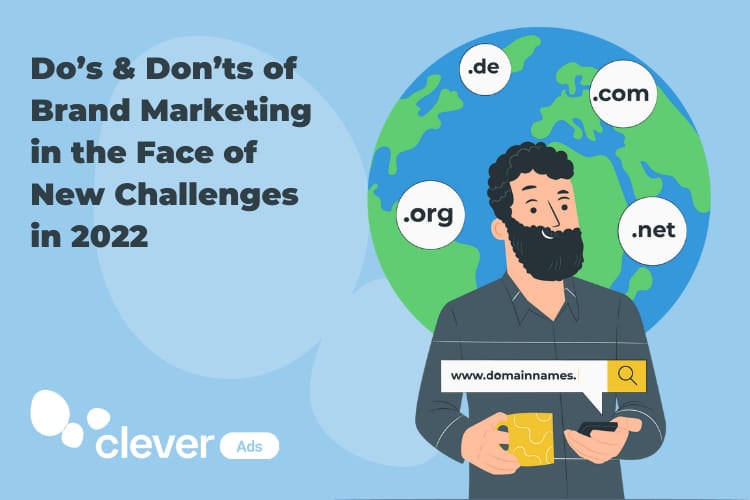Do’s & Don’ts of Brand Marketing in the Face of New Challenges in 2024
The coronavirus pandemic is still creating challenges for the marketing environment. Some of the challenges could have been predicted, while others caught the market completely by surprise. The ability to manage image as well as how to do a brand marketing properly has become the biggest problem facing businesses from local mom and pop shops to international brands. Knowing how to navigate this new landscape is one of the most important ways to make sure it is not only possible to survive through a crisis, but how to come out ahead of the pack. To do this, there are a few do’s and don’ts you will need to follow.
Do: Take Action to Stand Apart from the Competition
One of the biggest mistakes any company can do when there is a crisis is to simply “go dark”. The idea of sticking your head under the sand comes to mind when thinking about taking no action when the market is in chaos. There is an opportunity to be had in taking a stance during such uncertain times. By letting consumers know where you stand, they are not forced to attempt to infer your position. Show you have a positive message for everyone to help them get through these troubled times and more reason to trust your brand over another. Try to think about the brands you have seen taking a stand in comparison to those who remained silent and you will begin to realize how your allegiance may have been swayed by this action.
Do: Personalize Your Brand Image for Email Marketing Success
Email marketing has been emerging as one of the consistent marketing methods to reach consumers. This is due in large part to the amount of control marketers have over the email messages themselves. Of course the email address, and how it is acquired, also plays a large part in the success of email marketing campaigns. Something as simple as an email follow-up tool can work wonders to manage your brand. Take for example when someone makes a purchase, they appreciate receiving an email with a receipt and information about their purpose. This email, or one sent separately, can be personalized to the individual with a message they can identify with. Utilizing such information as past performance (purchases, browsing habits, conversion rates, preferences, etc.) allows you to craft a message with a greater likelihood of not being ignored.
Don’t: Fall in Line with the Standard Message
Almost as dangerous as having no message is to have the same message as everyone else. In the beginning of the pandemic every company scrambled to find a voice. Most felt compelled to show their empathy for being stuck in quarantine. What the market was flooded with were images and videos of people behind windows and stuck in their homes. It became white noise as a result. It was almost impossible to tell one brand from another and was ignored out of hand. This is a unique opportunity to show what the company stands for and why you stand above the rest. Taking a radical approach is not required here. Instead, it is just as simple as taking stock about what you would want to hear when you are considering who to do business with. Craft a message with this in mind to cement a message of unity in a time when people need to feel more together than ever before.
Don’t: Forget the Future Is Closer than You Think
It can be easy to fall into the lull of only thinking about the crisis we are facing and how to get through it. Marketing for the present is a dangerous proposal. Marketing should always be looking to the future. As such, any marketing plans should engage people to think about what is down the road. Reminding people about the fact the crisis is a perfect way to obtain a position ahead of the pack. This takes a lot of forethought into what the landscape will look like after the crisis has passed. You need to be able to answer the question about what the mentality of your consumers will be and how best to position your company to be fully engaged in the new environment. Take some time to look at the previous crises the world has undergone and how the emerging landscape changed as a result. Did people run out and seek out the things they have been denied, or did they simply maintain the behavior they engaged in during the crisis? Preparing for the future gives you a great game plan for how to manage your brand during the crisis.
Do: Engage in Micro – Trends as They Happen Not After
Following trends is easy to do once they have been identified. Engaging with a trend as they emerge is a little trickier. This is why it is important to never become complacent about where your marketing strategy is. By constantly evaluating the market and what your consumers are interested in, you can understand how to identify with them. For instance, social media marketing has been a dominant trend in the marketplace for years now. Getting influencers to highlight certain products has helped brands to not only maintain traction, but it has launched brands. Moving forward, there is likely to be less importance placed on this trend. Not only are influencers becoming price restrictive, but the actual brand influence they provide is being diminished. Finding the next trend to engage with your customers before influencers lose their hold completely puts you at an advantage against your competition.
Don’t: Ignore What Your Customers Are Telling You
Crafting your message can be as simple as listening to your customers. The questions they ask signify what their concerns are about your brand. Logging questions asked through media platforms, as well as reviews of products/services, provides plenty of insight. It is the most direct way to discover what people are placing the highest proprieties on. As such, you should be taking advantage of email marketing to maintain contact with your customers. Asking them to provide you with feedback is an essential tool for direct marketing in a manner they will receive. It is the equivalent of having the customer opt-in for receiving promotional material.
Do: Optimize for Mobile Usage of All Marketing Tools
Whether talking about a website or email, it is essential to take into consideration the dramatic increase in phone usage throughout 2021. More people than ever use their phones to browse the internet, check emails, and engage in social media. The last thing you want is for your customers to be thrown off by trying to decipher a pinched screen because it was not optimized for mobile use. Mobile optimization should be utilized to make sure the pages and emails will automatically convert based on the type of device being used. Tools are available to assure marketing materials can easily be viewed regardless of what type or size device is being used. Some marketers make the unfortunate presumption that all mobile devices are the same. Just looking at the difference between a tablet and a smartphone makes it evident screen size should play a factor in how the content is configured.
Following these suggestions allows you to have an easier time navigating the difficult landscape created throughout 2024. Best of all, this also provides you with a roadmap for how to be ahead when thinking about your seasonal marketing strategy for 2024.
 Michael Habiger is a content marketing specialist with over 6 years of experience, currently head of the marketing department at FollowUpFred. He is a marketing nerd and front-fighter for big data and automation.
Michael Habiger is a content marketing specialist with over 6 years of experience, currently head of the marketing department at FollowUpFred. He is a marketing nerd and front-fighter for big data and automation.
–




